Neon Tetras are regarded as very challenging to breed because of the specific water conditions needed for it to happen.
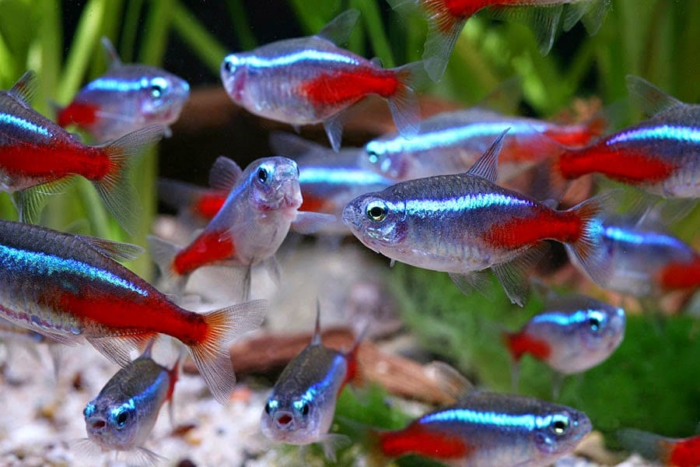
Having Neon Tetra eggs in your aquarium by accident is very unlikely if you haven’t put efforts into the breeding process. Each fertilized egg is less than 1 millimeter in diameter and is transparent.
If the eggs have a solid white color and you’re able to easily see them – they’re not fertilized and won’t ever hatch.
Here’s what unfertilized eggs of a Neon Tetra look like:
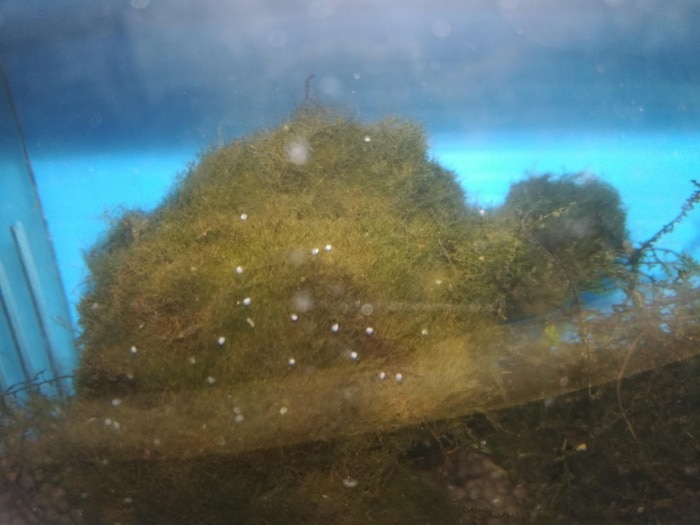
by dudeguy_79
With that out of the way, let me show you what you to do with your freshly-laid Neon Tetra eggs if you’re actively trying to breed these fish.
What to do with Neon Tetra eggs?
When Neon Tetras lay their eggs, the females will scatter them, preferably among moss and plants, where the male can fertilize them.
They are not adhesive and will not stick to the plants or glass of the aquarium.
If you see eggs stuck to the glass, they’re probably not laid by a Neon Tetra.
Fertilized eggs will remain transparent until hatched.
They will be spherical and look almost like jelly balls.
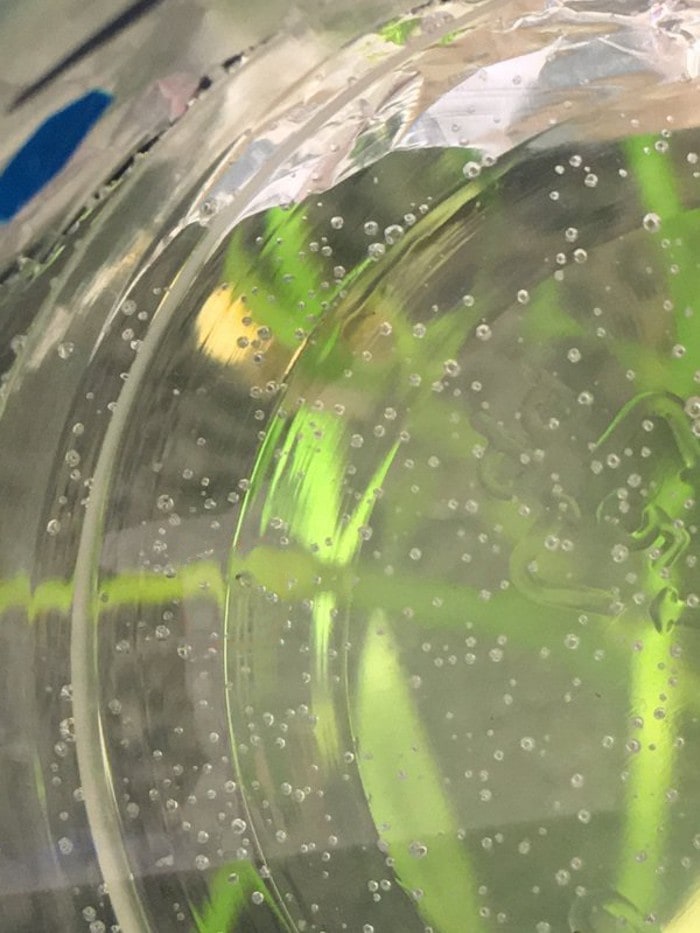
by jana
If they start turning white, it’s a sign they’re not hatching and that’s likely not your fault – the males just did not fertilize them.
If you’re unsure whether the eggs are fertilized, you can also try looking to see if you can identify a small black dot in the center.
This can be hard though because they are very tiny.
Here’s what you can do with newly-laid Neon Tetra eggs:
- You can leave the eggs as they are and they and any babies that hatch will likely get eaten by the parents or other fish in the tank;
- If the eggs are fertilized, you can try to hatch them which would mean relocating any adult fish to another tank and immediately turning off the aquarium’s lights.
You should take the decision shortly after you’ve noticed the eggs.
That’s because, assuming those are actual Neon Tetra eggs, they will start hatching approximately 24 to 72 hours after being laid.
Typically, during the first 24 hours after the eggs have been laid and fertilized the parent Neon Tetras won’t try to eat them.
However, if you don’t take the adult Neon Tetras out of the tank, the parents will snatch up any fry and eat them.
So to be on the safe side it’s best to remove the adults from the aquarium in that time window.
Keep babies and adults separate for around three months if you want to raise the babies.
What may be a bigger concern is overpopulating your tank as fry hatch and grow.
There’s a good chance several females will be ready to lay eggs, and they can quickly overpopulate a smaller tank under the right conditions:
One female Neon Tetra can lay between 60 and 130 eggs at a time. Under ideal conditions, only about 30% of the eggs will be successfully fertilized and hatch, so if your tetra lays 60 eggs, you’ll likely have around 20 fry.
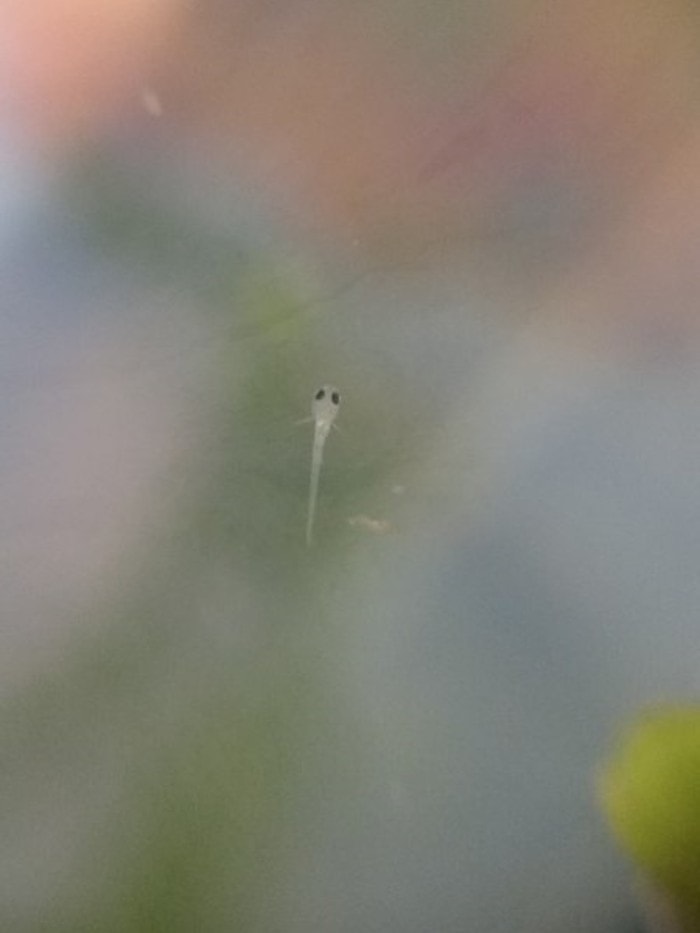
by SnookusFish
If you don’t want to breed Neon Tetras, you can simply let nature take its course and leave the eggs and any babies that hatch to be eaten by other fish or snails in the tank.
If at the 72-hour mark, after the eggs have been laid, there are still some that haven’t hatched, you may want to consider removing them from the tank.
This is especially true if you notice that there’s white, fuzzy stuff growing on their surface. This is a fungus that feeds on the unhatched eggs.
Removing unhatched eggs from a breeder aquarium is important because as they decompose, they will produce waste in the water. Any changes in water parameters or spikes in ammonia, nitrite or nitrate could be very dangerous to the newborn tetras, potentially stunting their growth or even killing them.
The best thing you can do to further protect the new Neon Tetra eggs, aside from removing the adults and all other fish from the tank, is to shut off the aquarium’s light.
Neon Tetra babies are light-sensitive.
Also, make sure the water flow in the breeding aquarium isn’t too strong.
That being said, in my experience, hatching and caring for baby Neon Tetras is the easiest part of the breeding process. That’s if your breeder tank’s water parameters are stable.
How to Hatch the Eggs of a Neon Tetra?
Before we get too much into the topic of hatching the eggs, it’s important to note a major distinction.
Many people seem to ask about their “pregnant” Neon Tetra when trying to learn more about their fish.
However, Neon Tetras are not live bearers and therefore will not ever be pregnant in the true sense of the word.
Pregnant fish are fertilized and give birth to live babies.
Neon Tetras are egg-bearing fish and reproduce by laying eggs to be fertilized externally by the males.
Author’s note: You’ll be able to tell if your females are carrying eggs when their bellies are swollen and enlarged, and the males are exhibiting courting behaviors. Males do a little dance, swimming in a square pattern while moving side to side.

by Wizard_g
Hatching fertilized eggs is pretty simple if your water conditions are already stable enough to trigger breeding.
The following steps will help you successfully hatch your Neon Tetras eggs:
1. Remove other fish from the aquarium
My advice: Put the egg-carrying female into a special breeding tank with a male when you notice she’s swollen. Let the fish breed, then remove the parents, and have the eggs hatch in the breeding tank.
Here’s a video of someone doing exactly that:
Make sure the breeding tank is established, and ideally fully cycled.
It’s a bonus if it has plenty of places to hide, like moss, plants, and rocks.
The female will prefer to lay her eggs somewhere hidden.
2. Turn off the lights
The eggs and fry of Neon Tetras are so sensitive to the light that it can kill them.
This makes sense, considering that Neon Tetras are native to the Amazon River’s murky waters.
3. Keep the temperature steady
Ideally, before the eggs are ever laid, the water will already be at a comfortable temperature to facilitate development and hatching.
The best temperature is between 73 and 76 degrees Fahrenheit (22.78 and 24.44 degrees Celsius), so you will want a heater in place. You don’t want the temperature to fluctuate while the eggs develop, and if the water is too hot or cold, it can prevent hatching.
4. Keep the pH balanced
The water should be what’s considered soft, with a pH of between 5 and 6.
Make sure you check these parameters before eggs are laid if you plan on using a separate breeding tank.
5. Keep or install a filter, and babyproof it
If your tank doesn’t have a filter, it needs one. This is especially true when the fry hatch and begin to grow.
Since you’ll be feeding them a lot there will be some ammonia produced, which needs to be processed, or it can kill them.
The problem many people have with filters in breeding tanks is that they worry the fry will be sucked up.
And yes, this is possible. You can avoid this by either using a sponge filter setup that won’t suck the fry up while filtering the water, or you can block your canister filter’s intake valve with a sponge or a thin mesh fabric that will prevent the fry from being pulled in.
Author’s Note: A trick I use in breeding tanks to protect the fry is to take a filter cartridge refill, then cut the poly-filter off and wrap that over the intake valve. Some people insist on using polyester or pantyhose, but if you block the flow of water too much, you can damage the filter because not enough water gets sucked up for it to run properly.
How to take good care of baby Neon Tetras after hatching?
Taking care of baby Neon Tetras after hatching might seem intimidating after all the hard work getting the adults to spawn.
However, it’s easier than you’d think.
As long as you keep your water in good condition, protect the fry from potential dangers, and feed them properly, they’ll grow up in no time.
With that said, baby Neon Tetras are fragile, and if you’re not on top of your aquarium’s water quality, they can quickly die.
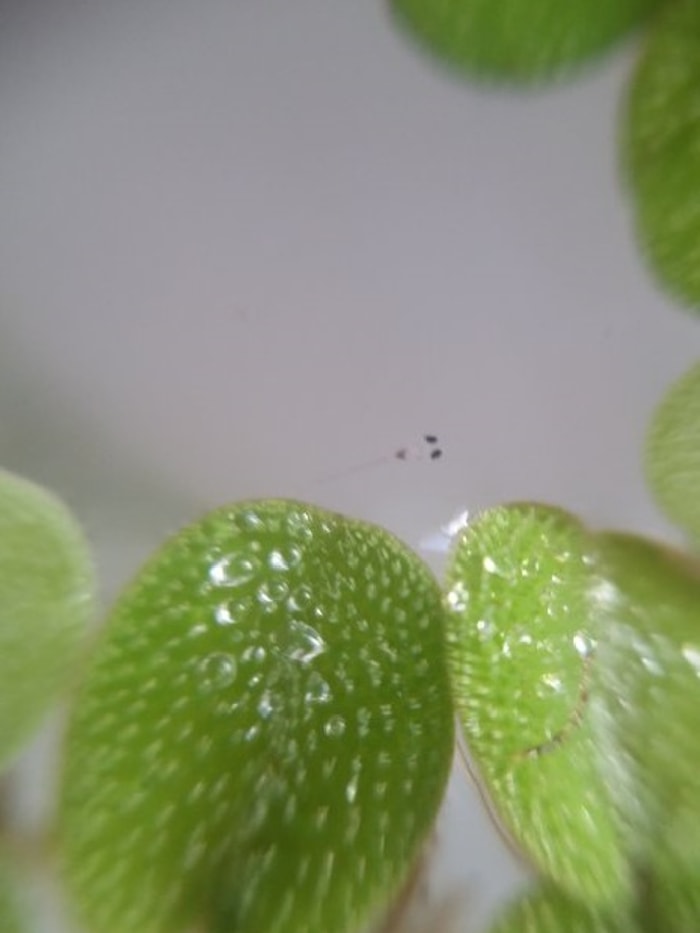
by SnookusFish
Baby Neon Tetras will need at least a 10-gallon tank, but bigger is always better. A 10-gallon tank is suitable for around 20-30 fry.
If you’re breeding several pairs at the same time, a bigger tank will be necessary.
As a bonus, larger tanks are always easier to maintain stable water parameters in, so if you can set up a larger breeding tank, I strongly recommend it.
Neon Tetra fry will need the water pH between 5.0-6.0 and right around 75 degrees Fahrenheit (23.89 degrees Celsius). Additionally, their water hardness should be between 1 and 2 dGH.
This will provide the optimal environment for the babies to grow.
In my experience, sponge filters are the best to use in tanks with fry.
Don’t forget to protect the fry from being sucked into the intake.
Likewise, you need to make sure the current isn’t strong enough to overwhelm the babies.
Sponge filters are usually gentle enough to avoid disturbing the water too much.
During the first several weeks, the fry will remain sensitive to light. Consider covering the sides of their tank with paper and adding floating plants to help keep it dark.
I prefer to keep light-sensitive fry like baby Neon Tetras in a room with blackout curtains just for the extra layer of darkness.
Once the babies hatch, it’s not quite time to feed them yet.
The first few days, up to a week, they get all of their nutritional requirements from their yolk sacs.
Glossary time: Some fish larvae have yolk sacs attached to them after they hatch. They use this yolk sac to feed.
Once the yolk sacs are gone, you can then begin feeding your Neon Tetra babies.
At first, I recommend offering a mix of:
- Infusoria
- Rotifers
- Squashed hard-boiled egg yolk
- Commercial fry food.
These will be small enough to be eaten by the fry.
Babies eat more than adult Neon Tetras. You can expect to feed your babies around four times per day to give them all the nourishment they need to reach their adult size. Feed them the amount that will be consumed in two minutes.
Author’s note: If there is food leftover in the tank, it’s important to take it out to avoid it rotting in the water and polluting the environment with additional ammonia. These fry are very sensitive to spikes in pollutants!
After a few more weeks, you can start introducing baby brine shrimp into the menu mix until the Neon Tetras are big enough to eat the same food you’re feeding the adults.
From eggs to adults – life cycle of Neon Tetras

by CooKieS
Baby Neon Tetras will go through six growth stages, beginning with the eggs, and each stage will have special considerations for care.
- Most commonly, the Neon Tetra mating ritual takes place overnight.
Eggs are usually laid early in the morning, and the male will fertilize them nearly immediately.
- After 24 hours, Neon Tetra eggs hatch into the larval stage. This is the stage where they still have the yolk attached that nourishes them.
- Once the yolk is gone, they are officially fry.
They will still be too small to really see well, especially because they tend to hide in the plants, but they will often come out for food or sit by the heater.
- It takes five days for fry to start swimming actively in the tank, but they are still very sensitive at this stage.
You’ll want to do partial water changes daily to keep parameters and waste levels in check. Be careful about how much water you replace, as too big of a water change can stress, or even kill the fish in the tank.
- After a month, your baby Neon Tetras will officially be juveniles. They’ll start gaining color and you’ll be able to see their spine and stomach.
They still do best on a diet of infusoria and egg yolk at this age.
- At two months old, Neon Tetras are called young and will start schooling together. They’ll be sexually mature at this age and look like miniature adults.
They may also start breeding if you don’t separate the males and females apart.
Female Neon Tetras will have a curved blue stripe while the males’ stripes will be straight. This is when you’ll want to start adding more protein in their diets.
At three months old, baby Neon Tetras can usually be added to a community tank as long as there’s nothing in it big enough to eat them. It will take about a year for them to reach their full size of about 1.3 inches (3.3 cm).
Neon Tetras can live for up to 8 years if you keep them in soft water.
This is plenty of time to have countless batches of eggs.
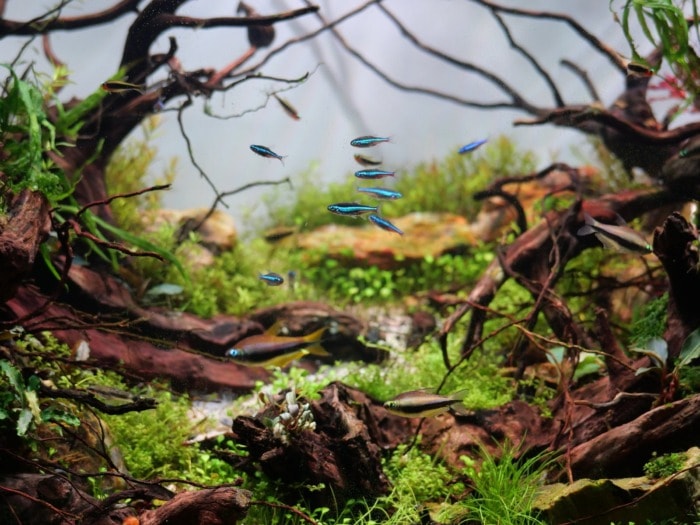
by CooKieS


